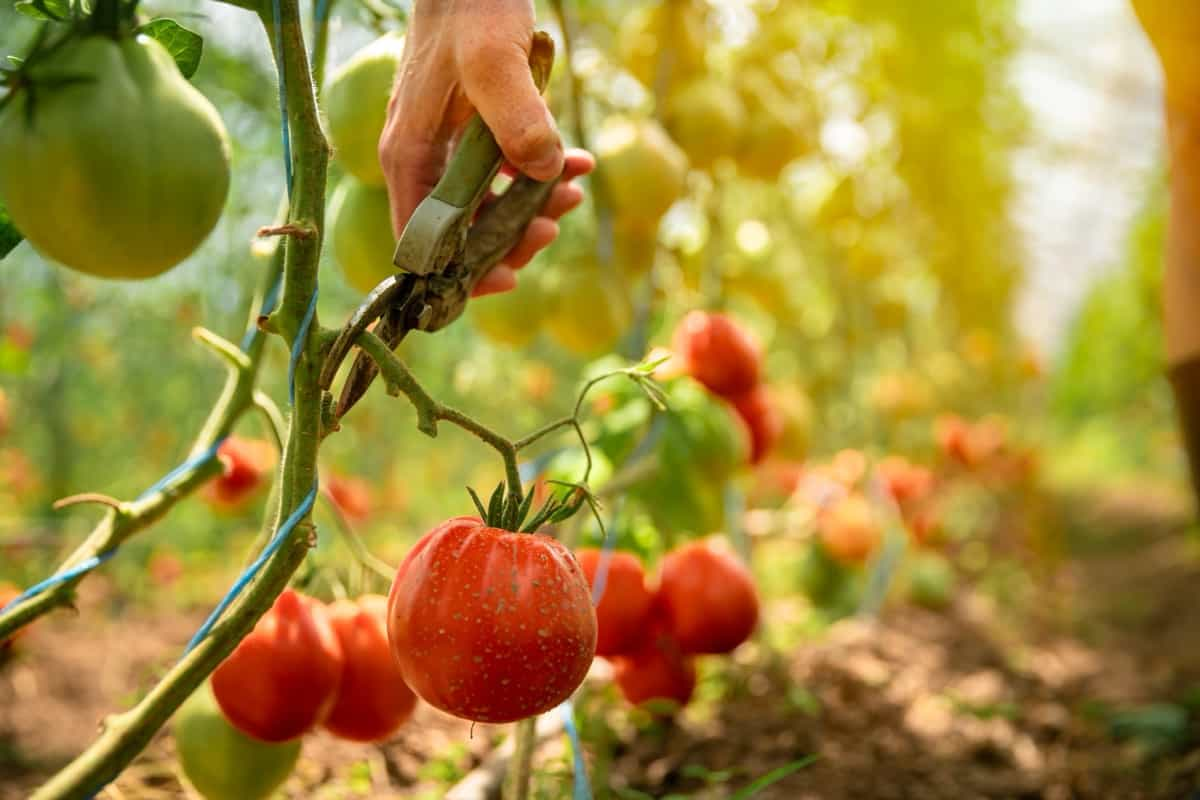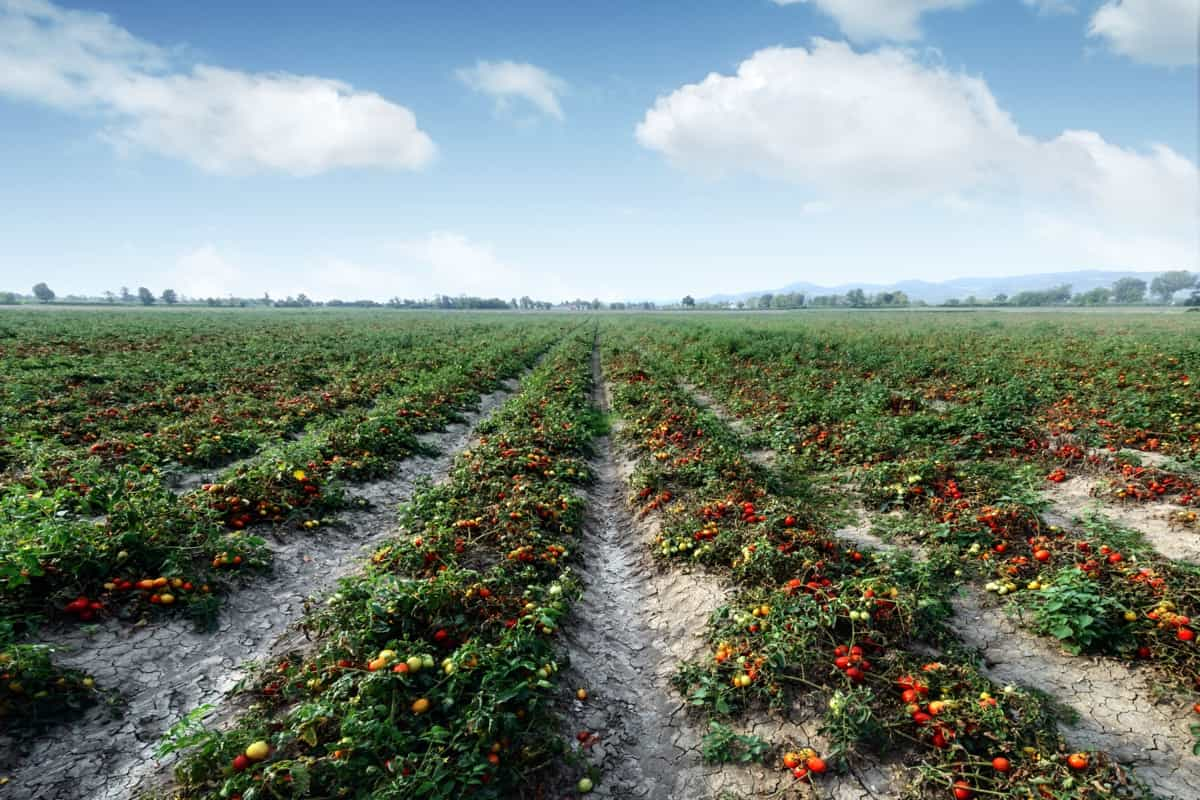Welcome to our summertime tomato-farming blog! It gets harder to grow a healthy tomato crop as the temperature rises. We’ll give you professional advice on cultivating delicious tomatoes during the warmest months in this article. Get advice on pest management, hydration, variety, and other topics to ensure a successful summer harvest.

Summer Tomato Farming
Introduction to Grow Tomatoes in the Hottest Months
Summer tomato farming poses unique challenges, particularly when dealing with the scorching heat. While tomatoes thrive in warm weather, excessively high temperatures can make their productivity standstill. When the mercury rises between 85°F and 90°F during the day, and nighttime temperatures consistently linger above 75°F, tomato plants often encounter difficulties.
The result is that their delicate flowers struggle to pollinate, leading to premature dropping and a temporary halt in new fruit production. In regions like the South, where temperatures frequently exceed 90°F during the day and 70°F at night for extended periods, these hurdles become common. However, with the right strategies, it’s possible to successfully cultivate tomatoes in the hottest months, ensuring a bountiful harvest despite the challenging conditions.
Ideal Growing Conditions for Summer Tomato Farming
- Sunlight: Tomatoes thrive in full sunlight, so choose a specific location with a minimum of 6-8 hours of direct sun daily.
- Temperature: Aim for daytime temperatures around 75-85°F (24-29°C) and nighttime temperatures above 55°F (13°C) for optimal growth.
- Soil: Well-drained soil, which is rich in organic matter is important. A pH level of around 6.0-6.8 is ideal for nutrient absorption.
- Water: Maintain consistent moisture levels. Deep, infrequent watering is preferred to prevent diseases and fruit cracking.
Best Tomato Varieties for Hot Summer Months
Choosing the right tomato varieties is crucial for a successful harvest. Some top picks for hot climates include heat-tolerant options like ‘Costoluto’ and ‘Brandywine’ for larger fruits, ‘Traveler 76’ known for its heat and drought resistance, ‘Cherokee Purple’ and ‘Yellow Pear.’ Hybrid choices like ‘Big Beef,’ ‘Early Girl,’ and the enduring ‘Celebrity’ also excel in hot conditions. For cherry tomatoes, ‘Porter Improved,’ ‘Sweet Million,’ and ‘Lollipop’ shine, while determinate varieties like ‘Heatwave II’ and ‘Homestead 24’ ensure reliable fruiting in the summer heat.
In case you missed it: How to Grow Tomatoes from a Tomato in 10 Simple and Easy Steps

How to Prepare the Soil and Beds for Summer Tomato Planting
Prepare the soil and beds for summer tomato planting; begin by selecting a sunny location. Clear the area of weeds and debris. Loosen the soil with tiller to a depth of about 12 inches. Incorporate organic matter like compost to improve drainage and fertility. Create rows or mounds for planting, leaving adequate spacing. Ensuring the soil is well-draining is essential, as waterlogged soil can harm tomato plants.
Providing Adequate Watering Techniques to Beat the Heat
Maintaining a consistent tomato watering routine is vital during the hot summer. Water properly, and allow the soil to dry between soakings to prevent fruit skin splitting and gray mold issues. Watch for greenhouse overheating in scorching weather, and ensure good ventilation by opening vents and doors. Adequate and timely watering and temperature control are key to thriving summer tomato plants.
Implement Mulching Practices for Summer Tomato Plants
Mulching is a great practice for summer tomato plants. Apply a two to three inch thick layer of mulch around the plants to retain the soil moisture, regulate temperature, and suppress weeds. Opt for organic materials like straw, shredded bark, leaves, or untreated grass clippings to enhance soil quality as they break down.
In areas with extended growing seasons, replenish the mulch in late summer. Alternatively, you can use bagged mulch products like Scotts® Nature Scapes® for convenience. Mulching not only conserves moisture but also supports healthier, more productive tomato plants during the heat of summer.
How to Control Pests and Diseases in Tomato Plants in Hot Weather
In regions with prolonged high temperatures, vigilant pest and disease management for tomato plants is crucial. Heat-stressed plants are more vulnerable to pests, so act promptly upon detection. Keep a watchful eye on issues. Hot weather can also accelerate the spread of diseases and remove affected or dying leaves to contain them. Regularly inspect your tomatoes, maintain good hygiene, and address problems swiftly to protect your crop in the sweltering heat. This proactive approach will help ensure a healthy and productive tomato harvest in hot regions.
How to Prune and Train Tomato Plants for Optimal Growth in Summer Hot Months
Pruning and training tomato plants are essential for maximizing growth during hot summer. For cordon (indeterminate) varieties, regularly pinch out the small side shoots that form between the main stem and branches. This hinders the plant from becoming overly bushy, ensuring energy goes into fruit production.
In case you missed it: Stupice Tomato Overview: Taste, Size, History, Origin, Growing, and Yield

Follow the advice of experts like Sarah Wain, who allows cordons to develop six trusses before tip removal to encourage ripening. Support your plants with sturdy polypropylene strings to prevent breakage under the weight of heavy fruit, especially beefsteak tomatoes. Proper pruning and support are key to a successful and manageable tomato crop.
Fertilizing Instructions to Promote Healthy Tomato Plants in Hot Climates
Proper fertilization is vital for robust tomato plants in hot climates. During summer, avoid excessive nitrogen, as it can divert energy to excessive foliage growth rather than fruiting. When your tomato plants start flowering, incorporate a liquid tomato fertilizer rich in potassium, like Vitax Liquid Tomato Food.
Potassium promotes fruit development and ripening. General-purpose fertilizers may encourage excessive leafy growth, so apply the tomato fertilizer at half the recommended rate with each watering. This practice ensures your tomato plants receive the nutrients they need to thrive in the heat while focusing their energy on producing a bountiful and delicious crop.
Harvesting and Storing Techniques of Tomatoes during the Summer Season
To fully enjoy the fresh flavor of tomatoes during the summer, harvesting and storing them is vital. Pick tomatoes when completely colored and slightly firm to ensure ideal ripeness. To avoid damage, gently twist or cut them from the plant. The best tomatoes are those that have been sun-ripened.
Store them at room temperature, away from sunlight, and never in the refrigerator since cold temperatures can dull their flavor and texture. Allow tomatoes to ripen inside if they are slightly underripe when harvested. Consider preserving or preparing sauces for longer-term storage. Summer tomatoes that have been properly harvested and preserved will continue to provide the delicious flavor of the season for a long time.
Common Mistakes to Avoid in Summer Tomato Farming
- Neglecting consistency: Inconsistent watering can lead to blossom end rot and fruit cracking. Maintain a regular watering schedule.
- Over-fertilization with nitrogen: Excessive nitrogen results in excessive foliage growth, hampering fruit production. Use balanced fertilizers or those rich in phosphorus and potassium.
- Poor disease management: Neglecting to address pests and diseases promptly can devastate your crop. Regularly inspect and take preventive measures.
- Overcrowding: Planting tomatoes too close together hampers air circulation, making plants more susceptible to disease. Space them adequately.
- Not selecting heat-tolerant varieties: Choose suitable tomato varieties for hot climates to ensure a successful harvest.
Frequently Asked Questions on Summer Tomato Farming
What Are the Best Tomato Varieties for Growing in Hot Summer Conditions?
Select varieties like ‘Heatwave II,’ ‘Homestead 24,’ ‘Cherokee Purple,’ and ‘Yellow Pear’ that are known for their heat tolerance.
How Do I Protect My Tomato Plants from Extreme Heat and Sun?
Provide shade during the hottest part of the day or use shade cloth. Ensure consistent watering and mulching to retain soil moisture.
What Are the Most Common Pests and Diseases That Affect Tomato Plants In Hot Weather?
Common pests include aphids and whiteflies, while diseases like blight can be problematic. Regular monitoring and early intervention are essential.
In case you missed it: How to Grow Tomatillo from Seed and How Tomatillo is Different from Tomato?

How Often Should I Water My Tomato Plants in The Summer?
Water deeply and consistently, allowing the soil to dry slightly between waterings to prevent overwatering or underwatering.
Conclusion
This guide provides essential tips for summer tomato farming, including selecting suitable varieties, ideal growing conditions, proper pruning, watering, and pest management. It emphasizes avoiding common mistakes like neglecting consistency, over-fertilization, poor disease management, overcrowding, and not selecting heat-tolerant varieties. Following these guidelines, you can enjoy a thriving tomato crop in hot climates, ensuring a flavorful harvest.
- Feed Your Flock for Less: Top 10 Tips to Save on Chicken Feed
- Ultimate Guide to Ossabaw Island Hog: Breeding, Raising, Diet, and Care
- Hatching Answers: The Top 10 Reasons Your Chickens Aren’t Laying Eggs
- Eggs and Economics: Breaking Down the Cost of Raising Backyard Chickens
- Defend Your Greens: Proven Methods to Keep Iguanas Out of Your Garden
- Ultimate Guide to Cinnamon Queen Chicken: A Comprehensive Guide for Beginners
- Ultimate Guide to California Tan Chicken: Breeding, Raising, Diet, Egg-Production and Care
- Ultimate Guide to Marsh Daisy Chicken: Breeding, Raising, Diet, and Care
- 10 Types of Chicken Farming Businesses You Can Start for Profits